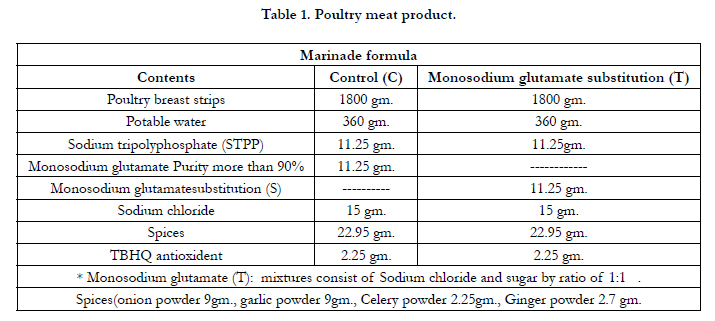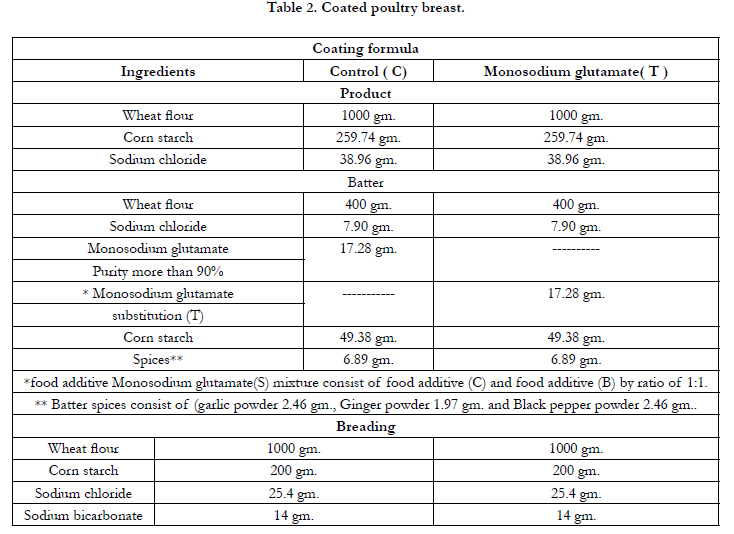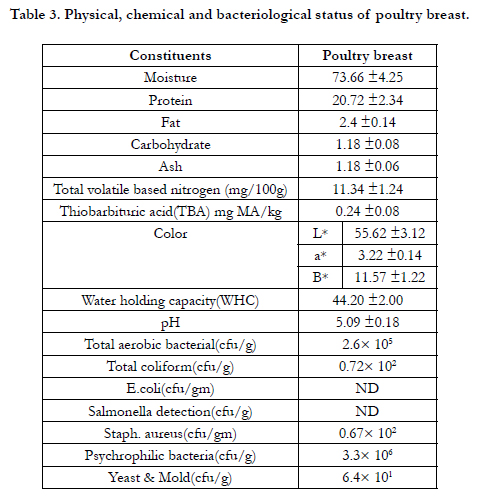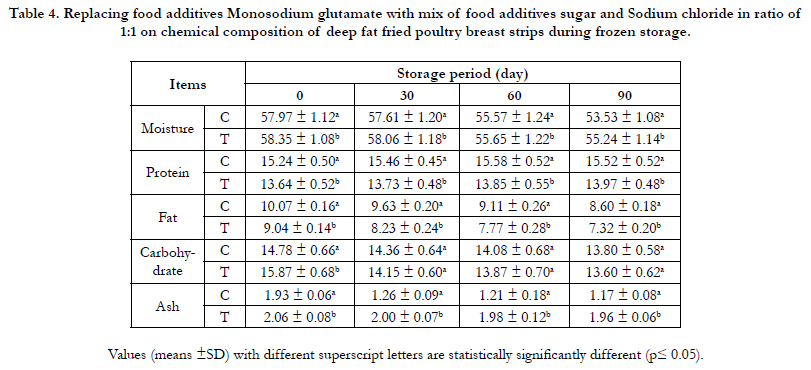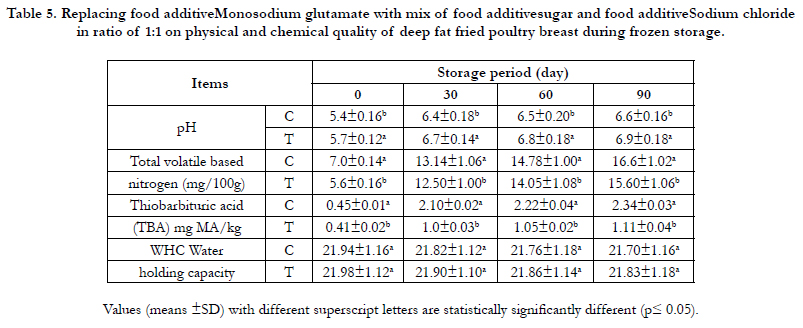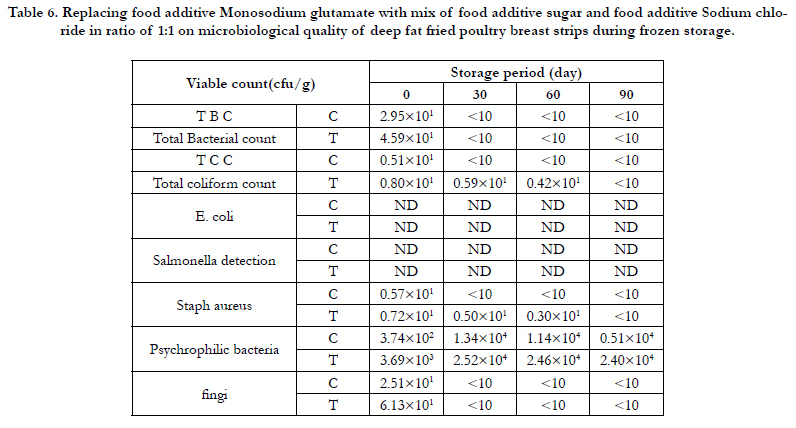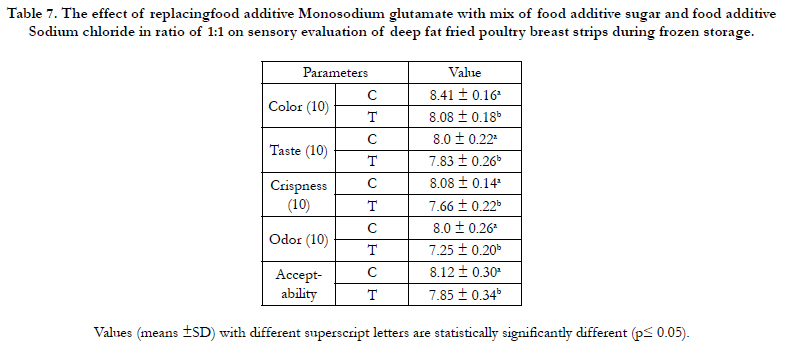Trials To Improve Quality Of Poultry Meat By Using Chemical Food Additives
Diaa Eldin, I.M.1, Eman T.Abou Sayed-Ahmed1, Hamada M. Hassan1, Fahim Shaltout2*, Gehan Abdallah El-shorbagy1
1 Department of Food Science, Faculty of Agriculture, Zagazig University, 44511 Zagazig, Egypt.
2 Department of Food Control, Faculty of Veterinary Medicine, Benha University, Egypt.
*Corresponding Author
Fahim Shaltout,
Department of Food Control, Faculty of Veterinary Medicine, BenhaUniversity, Egypt.
E-mail: FAHIM.SHALTOUT@fvtm.bu.edu.eg
Received: June 06, 2022; Accepted: August 25, 2022; Published: August 30, 2022
Citation: DiaaEldin, I.M., Eman T. Abou Sayed-Ahmed, Hamada M. Hassan, Fahim Shaltout, Gehan Abdallah El-shorbagy. Trials To Improve Quality Of Poultry Meat By Using Chemical Food Additives. Int J Food Sci Nutr Diet. 2022;11(6):620-629.
Copyright: Fahim Shaltout© 2022. This is an open-access article distributed under the terms of the Creative Commons Attribution License, which permits unrestricted use, distribution and reproduction in any medium, provided the original author and source are credited.
Abstract
Poultrymeat is included in food chains to use Part of this important commitment by using food additive Monosodium glutamate,
replacement monosodium glutamate with food additive sugar and food additive Sodium chlorideon physical, chemical,
bacteriological and sensory properties deep fat fried poultry breast strips during frozen storage for 90 days was examined.
Poultry control samples had higher moisture,carbohydrate and ash contents than the poultry treated fried samples, moisture,
carbohydrate and ash contents for all treatments and slightly decreased as storage period progressed. Food additives Monosodium
glutamate is a sodium salt that is derived from an amino acid called glutamic acid. It's naturally occurring in our bodies
and is in a whole bunch of other foods.
The protein and fat contents of deep fat fried poultry breast strips decreased by replacing food additive Monosodium glutamate
with a mixture of 1;1 sugar and Sodium chloride. The crude protein content of all treatments slightly increased as storage
period progresses, while fat content of all treatments slightly decreased as storage period progressed. Treatment contains mix
of sugar and Sodium chloride in ratio of 1:1 as food additives Monosodium glutamate alternative had a higher, WHC, cooking
loss, pH and lower TVBN, and TBA values than treatment containing Monosodium glutamate (control). The obtained
results also showed that control poultry breast strips had the highest counts of total bacterial count and lowest counts of total
coliform count, than other treatment. E. coli and Salmonella were not detected in both treatments until the end of storage
period. Adverse reactions could only be possible in people who may have sensitivities and who have consumed food additives
Monosodium glutamate.Since a typical serving of food with food additives Monosodium glutamate contains only 0.5 g of food
additive Monosodium glutamate, reactions are unlikely following typical meals.
Control poultry breast strips had the lowest counts of total Staph. aureus, yeast and mold and total psychrophilic bacteria
counts than other treatments, treatment containing food additive Monosodium glutamate (control) had higher sensory proprieties
(color, taste, crispness, odor and acceptability) than that treatment containing food additivesmix of sugar and Sodium
chloride as Monosodium glutamate replacer.
2.Introduction
3.Materials and Methods
4.Results and Discussions
5.References
Keywords
Food Additive; Frying; pH; TVBN; TBA.
Introduction
Poultry meat is a major component of the human healthy diet
worldwide that is low in fat and cholesterol as compared to other
meats as well as it is an excellent source of high- quality animal
proteins, vitamins, and minerals [48]. In recent years, poultry meat
products are considered one of the most products which attract
the consumers because they represent quick, easily prepared meat
meals with high health benefits and good flavor [56]. Rapid reproductive
cycle, high acceptability of poultry meat due to its high
biological value, palatability and many production processing variables;
made poultry production one of the major worldwide food
industry [52]. People have been using food additive Monosodium
glutamate to season their food for over 100 years. Some people in
Japanese cultures consider food additive Monosodium glutamate,
or umami, to be one of the five basic tastes. Many dishes featured
in Japanese, Chinese, and South Asian cuisine use food additives
Monosodium glutamate, the following food products may also contain food additive Monosodium glutamate, frozen meals and
processed meats, such as pastrami, sausages, lunch meats, smoked
meat products, hamburgers, cold cuts, salami, sauces and dressings,
such as ketchup, mayonnaise, barbecue sauce, salad dressing,
soy sauce, mustard, soup bases, such as bouillon cubes and granulated
powders, snacks, such as potato chips, seasonings, spices,
bodybuilding protein powder, fast food, such as poultry nuggets,
burgers and fried poultry. The food additiveMonosodium glutamate
potentially being harmful to human health noticed palpitations
and numbness in his neck, back, and arms after he had
eaten Chinese food “Chinese restaurant syndrome.” This term is
now outdated, and people use the term “Monosodium glutamate
symptom complex” instead, symptoms may have been the result
of a number of dietary factors including sodium, alcohol, and
food additives Monosodium glutamate (Monosodium glutamate
as being the main cause). Over the years, people have proposed
many different reasons asfood additive Monosodium glutamate
may be harmful to human health, food additive Monosodium
glutamatecan cause brain damage. The investigators noted that
the food additive Monosodium glutamate caused neuronal cell
death in several areas of the developing brain. The food additive
Monosodium glutamate damaged the hypothalamus, which plays
a crucial role in maintaining homeostasis. The effects of humans
ingesting small amounts of food additive Monosodium glutamate
from food into their gastrointestinal tract. food additive Monosodium
glutamate can cause obesity. food additive Monosodium
glutamate caused the participants to gain weight even in the absence
of processed foods or a lack of physical exercise, this result
may be due to the fact that Monosodium glutamate may influence
a person to overeat, because Monosodium glutamate makes food
taste better, people may be more tempted to overeat. headachses
after eating foods containing food additive Monosodium glutamate.
there was a link between Monosodium glutamate consumption
andcancer risk. Experiencing asthma episodes after eating
food additive Monosodium glutamate. Thelink between Monosodium
glutamate, diet, and asthma in adults have found correlation
between asthma and Monosodium glutamate consumption.
some people have reported being hypersensitive to Monosodium
glutamate. Monosodium glutamate occurs naturally in food and in
the body. Some manufacturers add it to food, such as fast food,
to improve flavor. Food additive Monosodium glutamate is safe
to eat. Links between food additive Monosodium glutamate and
certain health concerns have used amounts of food additive Monosodium
glutamate that a person is unlikely to consume as part
of a meal. If a person does feel that they have sensitivity to food
additives Monosodium glutamate, they can stop eating it. Food
allergies, Blood-thinning foods, drinks, and supplements. There
are many things people can eat and drink that may help keep the
blood thin and reduce the chances of developing dangerous clots.
Several major manufacturers have announced to move away from
using artificial ingredients and flavors in their products. food
additiveMonosodium glutamate is one such ingredient that has
been controversial for decades. It is one of the ingredients that
some companies have committed to remove from products [38].
Monosodium glutamate is a flavor enhancer commonly added to
processed food products like poultry to boost the palatability. Its
remarkable effects on the sensory appeal have been proven in
various studies [6, 36]. Removal of this ingredient is very likely
to cause reduced consumer acceptability. Using food additive
Monosodium glutamate substitute is a promising approach to
compensate for the sensory satisfaction loss caused by Monosodium
glutamate elimination. The flavor enhancement effect of
food additive Monosodium glutamate is mainly from glutamate
which contributes to umami or savory taste sensation. Besides
glutamate, there are several other umami eliciting components
such as aspartate and 5’-ribonicleotides. Among nucleotides, inosinate
(IMP) and guanylate (GMP) significantly contribute to flavor
and taste enhancement [59]. Theoretically, substances that are
naturally rich in umami components have the potential to replace
food additive Monosodium glutamate in food products. Consumers
preferred natural extracts such as yeast extract, mushroom extract,
and tomato extract as Monosodium glutamate substitute in
poultry products [60].
food additives Sugars may also contribute to umami taste characters
in the form of glutamate glycoconjugates [23]. Furthermore,
salts of potassium are also responsible to enhance umami taste
strength. However, during boiling process, significant levels of
potassium leach out from potatoes [7, 61]. Food additiveSodium
chloride is an important ingredient added to most of foods which
contributes to flavor enhancement and food preservation [10].
Food additive Monosodium glutamate is a flavor enhancer that is
found in some processed foods and Chinese cuisine. To avoid this
sodium product there are some potential substitutes can be used
as substitutes for food additive Monosodium glutamate. Use 1:1
ratio mixture of food additive sugar sugar and food additive Sodium
chloride as a substitute ingredient to your recipe instead of
Monosodium glutamate. This is safer to use, especially if you have
children at home. Monosodium glutamate is a food additive used
as a flavor enhancer [36]. The advantage of food additive Monosodium
glutamate goes to those who easily lose their appetite.
This is a very common ingredient in fast foods and food seasonings.
Food additives Monosodium glutamate is actually harmless
but too much consumption would cause headaches and this is not
good for people who have vertigo (a sensation of spinning) [32].
Currently, there is limited research comparing the enhancement
effects of food additive Monosodium glutamate with these natural
extracts in food products. Given the capability of salty taste
enhancement, food additive Monosodium glutamatesubstitute
may also be able to increase the sensory appeal of meat products
with reduced Sodium chloride content. Previous study indicated
that used of yeast extract successfully enhanced the taste of fermented
sausage [9]. Ground mushroom has also been reported
to improve the flavor of taco blend [37]. To replacefood additive
Monosodium glutamate, it is necessary to conduct more research
to compare the performance between Monosodium glutamate
and its alternatives infood additive Sodium chloride -reduced
food matrix [53].
The aim of the current study was to investigated the effect of
replacement food additive Monosodium glutamate with 1:1 ratio
mixture of food additive (B) sugar and food additive Sodium
chloride on quality properties deep fat fried poultry breast during
frozen storage.
Materials And Methods
Materials
Poultry breast 74.33% moisture 20.72% protein, 2.26% fat, 1.18%
carbohydrate, 1.18 Ash and pH 5.09, were obtained after 8 h of
Methods
Preparation of poultry breast strips: After preparation of
poultry breast strips as described (Tables 1 and 2), samples divided
into two groups: control group containing food additive
(A) Monosodium glutamate (C) and the other containing food
additiveMonosodium glutamate substitution (T).
Preparation of marinade solution: The amount of water below
5° Cwas placed in a bag of high density polyethylene, after that
the amount of food grade sodium tripolyphosphate (STPP) was
dissolved in it, followed by dissolving the food additiveSodium
chloride and food additive Monosodium glutamatein the case of
control or food additive Monosodium glutamate substitution (a
mixture of Sodium chloride and table sugar in a ratio of 1: 1) in
the case of treatment and then add spices, antioxidant, and stirring
to homogenize the marinade solution. The amount of raw
poultry fillet strips was added to previous brine after thawing it
for 24 h in the refrigerator and reaching a temperature. The bags
were closed and flipped for five minutes and placed in the refrigerator
on a temperature.
After one day, the bags were opened and the poultry breast strips
were removed from the soaking solution and put on a stainless steel net for 5 min to drain excess brine solution, then the increase
in the weight of poultry breast acquired from the marinade solution
was calculated according to the following formula [50].
% marinade uptake = marinated weight - raw weight/raw weight
- 100.
Deep-frying of marinade poultry breast: One and half liters
of a mixture of sunflower and soybean oil 1: 1 were placed in an
electric fryer and the oil temperature was raised to 186: 188°C,
then the marinated and covered poultry breast slices were placed
in the oil at a rate of 4 pieces each time and the weight of the
piece was approximately 40 g .When the temperature of the poultry
breasts reached 74 - 76°C, they were removed from the oil and
placed on a stainless steel mesh to get rid of the excess oil from
the throwing process in the control sample. In the treatment sample
(without Monosodium glutamate), the same previous steps
were repeated after getting rid of the frying oil used in the control
sample and replacing it with a new oil of the same type of oil.
Samples were preserved by freezing until the completion of the
tests [39, 50].
Chemical examination: Chemical ingredients Moisture, ash,
crude protein, and crude lipids (%)were determined according to
the methods recommended by AOAC (2007) [1], while total carbohydrate
content was measured by difference.
Bacteriological examination:
Preparation of samples for bacteriological examination: The
Ten grams of each sample were homogenized with 90 mL of
sterile saline solution (9 g NaCl/ L distilled water). The suspension
was shocked by shaker for 5 min to give 0.1 dilutions. Then
different dilutions (1: 10-1 to 1: 10-6) were prepared to be used
for microbiological examination.
Total bacterial count:
The Total bacterial count was performed as [49].
fungi:
Potato dextrose agar was used for yeast and mold enumeration.
Plates were incubated at 25°C for 5 days, according to APHA
(1992)[5, 21, 48].
Total Coliform bacteria count:
Violet red bile agar was used for the enumeration of coliforms.
Plates were incubated at 37°C for 24 h, according to APHA
(1992) [5].
Staphylococcus aureus bacteria:
Staphylococcus aureus test was performed as described in ISO,
4833-1 (2013) "" on page 628 and Shaltout (2022) [48].
Salmonella sppbacteria
Salmonella spp test was performed as described in ISO, 6579
(2004) and Shaltout et al., (2019) [51].
Freshness examination:
pH Value (ES 63/11, 2006):
By using astomacher, approximately 10 g of the examined sample
were homogenized with 25 mL of neutral distilled water, and
left to stand for 10 min at room temperature with continuous
shaking and filtered. The pH was determined by using electrical
pH meter (ACTWA-AD1200-1034678) calibration of pH meter
by using two buffer solutions of exactly known pH (alkaline pH
7.01, acidic pH 4.01). Therefore, pH electrode was washed with
neutralized water and then introduced into the homogenate.
Determination of total volatile basic nitrogen (TVB/
N)”mg” %( ES 63/10, 2006):
Ten g of sample were minced in a stomacher for 1-2 min until homogenization.
Then in a distillation flask add 2 g of magnesium
oxide and 300 mL distilled water to the minced sample. Make
distillation and receive 100 mL distillate within 30 min in a beaker
contain 25 mL of 2% boric acid. Then titrate against H2SO4
0.1M until faint pink color.
TVN mg/100g = R× 14
Where R is the volume of H2SO4 exhausted in titration.
Determination of thiobarbituric acid (TBA)”mg/Kg” (ES
63/9, 2006) and Shaltout (2022):
For detection of TBA number which is expressed as milligrams
of malondialdehyde equivalents per kilogram of sample. Ten
grams of sample were blended with 48 mL of distilled water, to
which 2 mL of 4% of ammonium chloride (to bring’s the pH to
1.5) were added in astomacher for 2 min and left at room temperature
for 10 min. The mixture was quantitatively transferred into
Kjeldahl flasks by washing with additional 50 mL distilled water,
followed by an anti-foaming preparation and few glass beads. The
Kjeldahl distillation apparatus were assembled and the flask was
heated to 50°C. 50 mL distillate was collected in 10 min from the
time of boiling commences. The distillate was mixed, and then
5mL was pipette into a glass- stoppard tube. 5mL of TBA reagent
(0.2883g/100mL of 90% glacial acetic acid) were added. The tube
was stoppered, shacked and immersed in boiling water bath for
35 min.A blank was similarly prepared using 5mL distilled water
with 5ml TBA reagent and treated like the sample. After heating,
the tube was cooled under tape water for 10 min. A portion was
transferred to a curette and the optical density (D) of the sample
was read against the blank by means of spectrophotometer (Perkin
Elmer, 2380, USA) at a wave length of 538nm.
TBA value (mg malondialdehyde /kg of sample) = D× 7.8
D: the read of sample against blank.
Physical examination:
Water holding capacity (WHC) and plasticity:
The water holding capacity (WHC) and plasticity were measured
according to the method described by [57]. A weight of 0.3 g of
ground meat was placed under ash less filter paper (Whatman, No. 41) between tow glass plates (20x20 cm) and pressed for 10
min., using 1 Kg weight. Two zones were measured using the
planimeter, the water holding capacity was calculating by subtracting,
the area of the internal zone from that of the outer zone. The
internal zone represented the plasticity. Results were presented in
cm2 per 0.3 g of raw sample.
Cooking loss:
The samples weighing 25-30 g (W1) were packed in plastic tubes.
The tubes were then heated at 95°C, until the internal temperature
of the samples reaches 75°C. The temperature was checked using
thermocouples inserted in the center of the sample. The samples
were considered cooked when the internal temperature reached
75°C after cooking, the meat was weighed again (W2) to determine
the loss in weight during cooking as described by [33, 48].
Cooking loss (%) = (W1- W2/ W1) x 100
Sensory examination:
Ten experienced panelists made a sensory evaluation of full fried
poultry strips.For the following attributes, each panelist was invited
to give a numerical value from 0 to 10. Scores extended from
1 to 10 which illustrate dislike extremely to the like extremely,
texture, color, odor and crispness [43, 48].
Statistical Analysis:
All data of the present study were subjected to analyses of variance
(AVOVA) using software (SAS institute, 1998) [46]. Differences
between means were collected by the least significant differences
(LSD) at p< 0.05.All measurements were carried out in
triplicate.
Results And Discussion
Physical, chemical and bacteriological examinations of
poultry breast:
The chemical composition of raw poultry breast strips is presented
in Table (3). Moisture, protein, fat, carbohydrate and ash
contents of raw poultry breast strips were (73.66, 20.72, 2.4, 1.18
and 1.18 g/100g respectively. These results are in agreement with
the data obtained by [40, 48], who found that moisture; protein,
fat and ash contents of raw poultry breast meat were 75.10, 22.90,
0. 78, and 1.30 g/100g. ,respectively.
The total volatile based nitrogen (TVBV) (mg/100g) and thiobarbituric
acid milligrams of malonaldehyde (TBA) mg / kg of raw
poultry breast strips were (11.34 mg/100g and 0.24 (MA) / kg),
respectively. These results are in agreement with the data obtained
by [28].
Data presented in Table 3 showed that the color values (L*, a*,
and b*) of poultry strips were 55.6, 3.2 and11.5 respectively.
Whilewater holding capacity (WHC) and pH values of raw poultry
strips were 44.2 and 5.09 respectively. These results are in
agreement with the data obtained by [27, 42, 48].
Total aerobic bacterial, coliform, E. coli, salmonella, staph. Positive
coagulase, psychrophilic bacteria and yeast and mold counts
of raw poultry breast strips were presented in Table 3. Total aerobic
bacterial, coliform, salmonella, staph.aureus, psychrophilic bacteria and yeast and mold counts were 2.6×105, 0.72×102, ND,
ND, 0.67×102 , 3.3×106 and 6.4×101 respectively. These results
are in agreement with the data obtained by [4, 14, 44, 49].
Chemical examination of deep fat fried poultry breast during
frozen storage:
Poultry breast samples chemically examined to determine the
gross chemical composition and physical properties. It could be
noticed that moisture loss of deep fat fried poultry breast strips
significantly decreased as a function of storage time for both samples.
The control samples had statistically higher moisture contents
than the treated fried samples. This could be due to water
loss during frying. All coatings provided a beneficial barrier for
moisture and preserved samples from moisture loss during storage.
The lower water loss for the coated deep fat fried poultry
breastmight be due to controlling the loss of water and reducing
dehydration. These results were agree with [24, 41, 48].
The crude protein content of deep fat fried poultry breast stripsdecreased
by replacingfood additives Monosodium glutamate
with a mixture of 1;1 sugar and Sodium chloride this may be
due to containing of food additives Monosodium glutamate on
amino acids.The crude protein content of all treatments slightly
increased as storage period progresses. Freezing storage has been
shown to induce protein carboxylation, and the formation of
Schiff bases in poultry meat [58]. Freezing storage has impacts on
the activities of endogenous proteolytic enzymes responsible for
the degradation of meat protein as well as the relaxation of meat
tissue structures [20]. Study conducted by [55] revealed increased
content of both total and soluble protein in breast meat after 6
weeks of freezing storage. Similar results were observed by [24,
41].
Fat content of poultrybreast died not affecting by replacing. Control
samples had the highest fat content than treated samples. The
fat content of all treatments slightly decreased as storage period
progressed. This decrease of fat content may be explained by the
autolysis of lipid [19, 48].
Carbohydrate and ash content were higher in sample containing
sugar and Sodium chloride mixture as alternative for Monosodium
glutamate. The observed reduction in ash content was probably
due to increased meat leakage during the fried process, hence
the subsequent increased loss of mineral salts. Chwastowska and
Kondratowicz, (2005) [11] also demonstrated the impact of thawing
(in atmospheric air and microwave) methods on the ash content
of pork meat.
Physical and chemical examinations of deep fat fried poltry
breast strips during frozen storage:
From data presented in Table 5. It could be noticed that the pH
value of deep fat fried poultry breast strips during frozen storage
of both treatments increased as storage period progressed.
Treatment contains mix of sugar and Sodium chloride in ratio of
1:1 as MSD alternative had the higher pH values than treatment
containing Monosodium glutamate (control sample). These results
are in agreement with those obtained by [24, 41]. The slight
increase in pH during storage may be due to inhibition of bacterial
activity during frozen storage as [8].
The TVBN of both treatments increased as storage period progressed.
Treatment containing mix of sugar and Sodium chloride
in ratio of 1:1 as MSD alternative had the lower TVBN values
than treatment containing Monosodium glutamate (control sample)
.The increasing in TVBN value due to the breakdown of
nitrogenous substances by microbial activity as reported by [13,
41, 48].
On the other hand, the TBA values of both treatments increased
as storage period progressed. Treatment contains mix of food
additive sugar and Sodium chloride in ratio of 1:1 asMSD alternative
had the lower TBA values than treatment containing food additive
Monosodium glutamate (control sample. These results are
in agreement with those obtained by [24, 41]. The increasing of
TBA value taken place due to lipid oxidation as reported by [18].
However, a high degree of poly unsaturation accelerates oxidative
processes leading to deterioration in meat flavor, color, texture
and nutritional value [35].
Water holding capacity (WHC) of deep fat fried poultry breast strips during frozen storage of both treatments decreased as storage
period progressed. Treatment contains mix of food additivesugar
and food additiveSodium chloride in ratio of 1:1 asfood
additives Monosodium glutamatealternative had the higher WHC
values than treatment containing food additives Monosodium
glutamate (control sample).These results are in agreement with
those obtained by [8, 41, 48].
Table 4. Replacing food additives Monosodium glutamate with mix of food additives sugar and Sodium chloride in ratio of 1:1 on chemical composition of deep fat fried poultry breast strips during frozen storage.
Table 5. Replacing food additiveMonosodium glutamate with mix of food additivesugar and food additiveSodium chloride in ratio of 1:1 on physical and chemical quality of deep fat fried poultry breast during frozen storage.
Table 6. Replacing food additive Monosodium glutamate with mix of food additive sugar and food additive Sodium chloride in ratio of 1:1 on microbiological quality of deep fat fried poultry breast strips during frozen storage.
Table 7. The effect of replacingfood additive Monosodium glutamate with mix of food additive sugar and food additive Sodium chloride in ratio of 1:1 on sensory evaluation of deep fat fried poultry breast strips during frozen storage.
The cooking loss of deep fat fried poultry breast strips increased significantly as storage period progressed for all samples.Treatments containing Monosodium glutamate had the higher cooking loss percentage values than control sample. These results are in agreement with those obtained by [2, 24, 29, 41, 45].
microbiological examination of deep fat fried Poultry breast during frozen storage:
The microbiology examinations of deep fat fried poultry breast strips during frozen storage were examined to determine some microbiological quality and shelf life validity throughout frozen storage. Microbial growth in meat and meat products can result in slime formation, structural components degradation, decrease in water holding capacity, off odors, and texture and appearance changes which reduce their quality, nutritional value and reduce the shelf life [12, 48].
Bacterial count:
Table 6 shows that there were significant differences in viable bacterial count between the control poultry breast strips and other poultry breast strips sample. The results indicated that total bacterial count decreased gradually throughout the storage period until the end of storage period. The obtained results also showed that control poultry breast strips had the highest counts of total bacterial count than other treatment. This might due to the antimicrobial activity of Sodium chloride or sugar [54]. Similar results were reported by [2, 8, 24, 30, 41].
Coliform bacteria:
Table (6) shows the differences in coliform counts. The results indicated that total coliform count decreased gradually throughout the storage period until the end of storage period. The obtained results also showed that control poultry breast strips had the lowest counts of total coliform count than other treatment. Similar results were reported by [8, 24, 41, 45, 49].
E. coli count:
The results presented in Table (6) indicated that total E. coli count did not detect in both treatments until the end of storage period. Similar results were reported by [8, 24, 41, 45, 49].
Salmonella count:
The results presented in Table (6) indicated that Salmonella did not detect in both treatments until the end of storage period. Similar results were reported by [8, 24, 41, 46, 51].
Staph.Aureus bacteria:
Table (6) shows the differences in Staph coagulase counts. The results indicated that total Staph aureus count decreased gradually throughout the storage period until the end of storage period. The obtained results also showed that control poultry breast strips had the lowest counts of total Staph coagulase count than other treatments. Similar results were reported by [8, 24, 41, 45].
Psychrophilic bacteria:
Table (6) shows the differences in psychrophilic bacteria counts. The results indicated that total psychrophilic bacteria count increased gradually throughout the storage period until the end of storage period. The obtained results also showed that control poultry breast strips had the lowest counts of total psychrophilic bacteria than other treatment.Similar results were reported by [8, 24, 41, 45, 48].
Fungal count:
The differences in yeast and mold counts of deep fat fried poultry breast strips during frozen storage are shown in Table 6. The results indicated that total yeast and mold count decreased gradually as the storage period progressed until the end of storage period. The obtained results also showed that control poultry breast strips had the lowest counts of total yeast and mold than other treatment. Similar results were reported by [8, 21, 24, 41, 45].
Sensory examination of deep fat fried poultry breast strips during frozen storage (-18°C):
Poultry meat is a nutritious food and it is consumed all over the world because of its relatively low cost and low fat content. However, it is highly perishable with a relatively short shelf life even when it is kept under refrigeration. Thus, developing more appropriate technologies for its preservation could be highly useful, in order to increase the shelf life of meat products [13, 34].
Statistical analysis appears a significant difference in sensory evaluation between both samples. Treatment containing Monosodium glutamate (control) had the higher sensory proprieties (color, taste, crispness, odor and acceptability) than that treatment containing mix of sugar and Sodium chlorideas Monosodium glutamate replacer Table 7.
The overall acceptability of deep fat fried poultry breast strips during frozen storage (-18±1°c) were significantly higher in (C), while it was significantly lower in the sample treated with mix of sugar and Sodium chloride as Monosodium glutamate replacer. Statistical analysis appears a significant difference in overall acceptability between both samples. These results are in agreement with those obtained by [3, 8, 13, 24, 41, 45].
Attempts to improve the quality of poultry products using food additives
Summary
The effect of replacing MSG with a 1:1 mixture of sugar and salt on the physicochemical, microbiological and sensory properties of fried chicken breast fillets during freezing storage (-18 ± 1°C) for 90 days was studied. The results showed that the control samples containing MSG contained a higher percentage of moisture, carbohydrates and ash than the fried samples treated, and the moisture, carbohydrates and ash contents decreased in all treatments with the progression of the storage period. The content of crude protein and fat decreased in fried chicken breast slices as a result of replacing monosodium glutamate with a mixture of 1, 1 sugar and salt. The content of crude protein increased in all treatments with the progression of the storage period, while the fat content decreased in all treatments with the progression of the storage period. The treatment containing a mixture of sugar and salt in a ratio of 1:1 as a substitute for MSG had the highest values in water holding capacity and losses during hydrogen cooking and the lowest values in total volatile nitrogen and thiobarbituric acid values compared to the treatment containing monosodium glutamate (control sample) as the results showed. It was found that the control chicken breast strips contained higher numbers of total bacteria and less coliform bacteria compared to the other treatment. E was not detected. coli and salmonella in both treatments until the end of the storage period. Control chicken breast fillets had the lowest total staph count. aureus, yeasts, fungi and cryophilic bacteria compared to the other treatment. The treatment containing MSG (control) had higher sensory properties (colour, taste, crunch, aroma, and acceptability) than the treatment containing a mixture of sugar and salt as an alternative to MSG.
References
- Agriculture and Agri-Food Canada [Internet]. Canada: Canadian dairy industry; c2007 [cited 2007]. Available from: http://www.dairyinfo.gc.ca/_ english/cdi/index.html
- Arbuckle WS. Ice cream. Springer; 2013 Mar 9.
- Flores AA, Goff HD. Ice crystal size distributions in dynamically frozen model solutions and ice cream as affected by stabilizers. J Dairy Sci. 1999 Jul 1;82(7):1399-407.
- Goff HD, Ferdinando D, Schorsch C. Fluorescence microscopy to study galactomannan structure in frozen sucrose and milk protein solutions. Food Hydrocoll. 1999 Jul 1;13(4):353-62.
- Krog N. The Use of Emulsifiers in Ice Cream in Ice Cream, W. Int. Dairy Fed.: Brussels. 1998:37-43.
- Marshall RT. In Marshall, RT, Goff, HD and Hartel, RW. Ice Cream. NY: Kluwer Academic. 2003;6:11-54.
- Marshall RT, Goff HD, Hartel RW. Ice cream. Springer. 2012;56-58.
- Sofjan RP, Hartel RW. Effects of overrun on structural and physical characteristics of ice cream. Int Dairy J. 2004 Mar 1;14(3):255-62.

